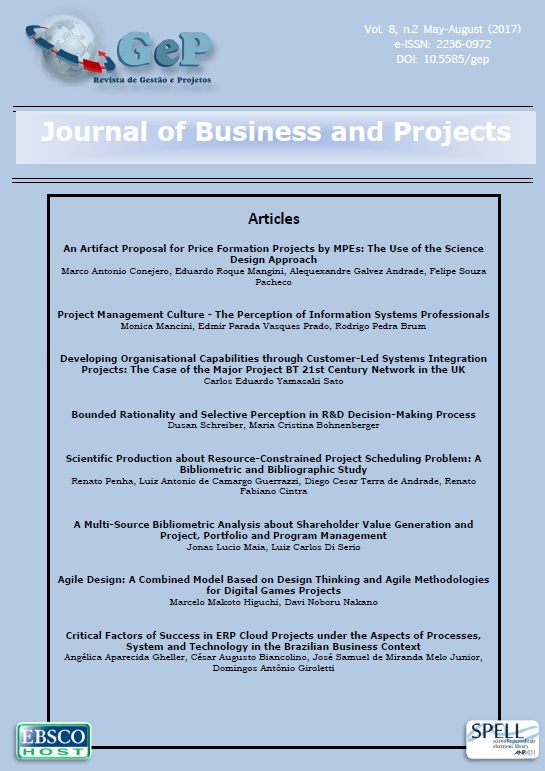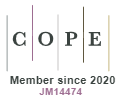Developing Organisational Capabilities through Customer-Led Systems Integration Projects: The Case of the Major Project BT 21st Century Network in the UK
DOI:
https://doi.org/10.5585/gep.v8i2.518Keywords:
Customer-Led Systems Integration Projects, Major Projects, Organisational Capabilities, Project Performance, BT 21st Century Network (BT21CN)Abstract
Traditional approaches to systems integration in major projects take the strategy of selecting a supplier-led prime/systems integrator. Although this strategy pushes a significant amount of risk to the supplier, project performance may suffer due to lower engagement of the customer in the anticipation of potential issues involving a major project. Thus, this research investigates the implications of the customer, as opposed to a selected external supplier, assuming the role of systems/prime integrator. A case study approach is conducted on the major project BT 21st Century Network (BT21CN) to demonstrate that customer-led systems integration projects may provide more balance in the relationship and distribution of risks between supplier and customer, having a positive impact on project performance and on accelerating the development of BT’s organisational capabilities.
References
Aritua, B., Male, S., & Bower, D. (2009). Defining the intelligent public sector construction client. Proceedings of the Institution of Civil Engineers - Management, Procurement and Law 162(2), 75-82.
Barney, J. B. (1991). Firm resources and sustained competitive advantage. Journal of Management, 17(1), 99-120.
Brady, T., & Davies, A. (2010). Learning to Deliver a Mega-project:The Case of Heathrow Terminal 5. In N. D. Caldwell & M. Howard (Eds.), Procuring Complex Performance: Studies of Innovation in Product-Service Management (pp. 174-198). New York: Routledge.
Brady, T., Davies, A., & Rush, H. (2006). Learning to manage mega projects: the case of BAA and Heathrow Terminal 5. Paper presented at the IRNOP VII Project Research Conference, Xi'an China.
Bross, M. (2003). BT - Transforming the Network for Enhanced Customer Focus, OpticalKeyhole.com http://www.opticalkeyhole.com/interviews/bt.asp accessed on 18th August 2003
Brusoni, S. (2005). The Limits to Specialization: Problem Solving and Coordination in 'Modular Networks'. Organization Studies, 26(12), 1885-1907.
Brusoni, S., & Prencipe, A. (2001). Unpacking the Black Box of Modularity: Technologies, Products and Organizations. Industrial and Corporate Change, 10(1), 179-205.
Brusoni, S., Prencipe, A., & Pavitt, K. (2001). Knowledge Specialization, Organizational Coupling, and the Boundaries of the Firm: Why Do Firms Know More than They Make? Administrative Science Quarterly, 46(4), 597-621.
Caldwell, N. D., Roehrich, J. K., & Davies, A. C. (2009). Procuring complex performance in construction: London Heathrow Terminal 5 and a Private Finance Initiative hospital. Journal of Purchasing and Supply Management, 15(3), 178-186.
Chagas Jr., M. F., Leite, D. E. S., & Jesus, G. T. (2017). “Processos acoplados” como capacidades dinâmicas na integração de sistemas. Revista de Administração de Empresas, 57(3), 245-257.
Chandler, A. D. (1990). Scale and Scope: The Dynamics of Industrial Capitalism. Cambridge, MA: Belknap Press.
Chang, C.-Y. (2015). Risk-bearing capacity as a new dimension to the analysis of project governance. International Journal of Project Management, 33(6), 1195-1205.
Chang, C., & Ive, G. (2007). The hold-up problem in the management of construction projects: A case study of the Channel Tunnel. International Journal of Project Management, 25(4), 394-404.
Christensen, C. M. (1997). The Innovator´s Dilemma: When New Technologies Cause Great Firm to Fail. Massachusetts: Harvard Business School Press.
Cleland, D. I., & Ireland, L. R. (2007). Project Management: Strategic Design and Implementation (5th ed.). USA: The McGraw-Hill Companies, Inc.
Davies, A. (2003). Integrated solutions: the changing business of systems integration. In A. Prencipe, A. Davies & M. Hobday (Eds.), The Business of Systems Integration (pp. 333-368). Oxford: Oxford University Press.
Davies, A. (2004). Moving base into high-value integrated solutions: a value stream approach. Industrial and Corporate Change, 13(5), 727-756.
Davies, A., & Brady, T. (2015). Explicating the dynamics of project capabilities. International Journal of Project Management, In Press.
Davies, A., Brady, T., & Hobday, M. (2007). Organizing for solutions: Systems seller vs. systems integrator. Industrial Marketing Management, 36, 183-193.
Davies, A., Gann, D., & Douglas, T. (2009). Innovation in Megaprojects: Systems Integration at London Heathrow Terminal 5. California Management Review, 51(2), 101-126.
Davies, A., & Hobday, M. (2005). The Business of Projects: Managing Innovation in Complex Products and Systems. Cambridge: Cambridge University Press.
Davies, A., & Mackenzie, I. (2014). Project complexity and systems integration: Constructing the London 2012 Olympics and Paralympics Games. International Journal of Project Management, 32(5), 773-790.
Dawson, C. (2006). A Practical Guide to Research Methods - A User-Friendly Manual for Mastering Research Techniques and Projects (2nd ed.). Oxford: How to Books Ltd.
Doz, Y., & Kosonen, M. (2008). Fast Strategy: How strategic agility will help you stay ahead of the game. Harlow: Pearson Education Limited.
Eisendhardt, K. M. (1989). Building theories from case study research. Academy of Management Review, 14(4), 532-550.
Eisenhardt, K. M., & Martin, J. A. (2000). Dynamic Capabilities: What are they? Strategic Management Journal, 21, 1105-1121.
Flyvbjerg, B., Bruzelius, N., & Rothengatter, W. (2003). Megaprojects and Risk: An Anatomy of Ambition. Cambridge: Cambridge University Press.
Frame, J. D. (2002). The new project management: tools for an age of rapid change, complexity, and other business realities (2nd ed.). San Francisco: Jossey-Bass
Frame, J. D. (2003). Managing Project in Organizations: How to Make the Best Use of Time, Techniques and People (3rd ed.). San Francisco: Jossey-Bass.
Fransman, M. (2002). Telecoms in the Internet Age: From Boom to Bust to...? Oxford: Oxford University Press.
Galbraith, J. R. (2005). Designing the customer-centric organization: a guide to strategy, structure and process. San Francisco: Jossey-Bass Business & Management Series.
Genus, A. (1997). Managing large-scale technology and inter-organizational relations: the case of the Channel Tunnel. Research Policy, 26(2), 169-189.
Ghapanchi, A. H., & Aurum, A. (2012). The impact of project capabilities on project performance: Case of open source software projects International Journal of Project Management, 30(4), 407-417.
Gil, N., Miozzo, M., & Massini, S. (2012). The innovation potential of new infrastructure development: An empirical study of Heathrow airport's T5 project. Research Policy, 41(2), 452-466.
Grant, R. M. (1995). Contemporary Strategy Analysis: Concepts, techniques, applications (2nd ed.). USA: Blackwell Publishers, Ltd.
Grundy, T., & Brown, L. (2002). Strategic Project Management: Creating Organizational Breakthroughs. London: Thomson Learning.
Hersent, O., Petit, J., & Gurle, D. (2005). IP Telephony: Deploying Voice-over-IP Protocols. Chichester: John Wiley & Sons Ltd.
Hobbs, B., & Besner, C. (2016). Projects with internal vs. external customers: An empirical investigation of variation in practice. International Journal of Project Management, 34(4), 675-687.
Hobday, M., Davies, A., & Prencipe, A. (2005). Systems integration: a core capability of the modern corporation. Industrial and Corporate Change, 14(6), 1109-1143.
Kapletia, D., & Probert, D. (2010). Migrating from products to solutions: An exploration of system support in the UK defense industry. Industrial Marketing Management, 39(4), 582-592.
Kerzner, H. (2006). Project Management: A Systems Approach to Planning, Scheduling and Controlling (9th ed.). Hoboken, New Jersey: John Wiley & Sons, Inc.
Kolb, D. A. (1985). Experiential Learning. Englewood Cliffs, NJ: Pearson.
Konrad, M., Chrissis, M. B., Ferguson, J., Garcia, S., Hefley, B., Kitson, D., et al. (1996). Capability Maturity Model at the SEI. Software Process: Improvement and Practice, 2(1), 21-34.
Le Quesne, T., & Parr, T. (2016). Major capital programmes: a discussion document based on insights from recent experience. London: HM Treasure and Cabinet Office.
Liinamaa, J., & Gustafsson, M. (2010). Integrating the customer as part of systems integration. International Journal of Managing Projects in Business, 3(2), 197-215.
Locatelli, G., Mancini, M., & Romano, E. (2014). Systems Engineering to improve the governance in complex project environments. International Journal of Project Management, 32(8), 1395-1410.
Loosemore, M., & Cheung, E. (2015). Implementing systems thinking to manage risk in public private partnership projects. International Journal of Project Management, 33(6), 1325-1334.
Mansell, R., & Steinmueller, W. E. (2000). Mobilizing the Information Society: Strategies for Growth and Opportunity. Oxford: Oxford University Press.
Maylor, H., & Blackmon, K. (2005). Researching Business and Management. New York: Palgrave Macmillan.
Maylor, H., & Johnson, M. (2009). ICPM White Paper: Cranfield School of Management - International Centre for Programme Management.
Melkonian, T., & Picq, T. (2011). Building Project Capabilities in PBOs: Lessons from the French Special Forces. International Journal of Project Management, 29(4), 455-467.
Nelson, R. R., & Winter, S. G. (1982). An Evolutionary Theory of Economic Change. Cambridge, MA: Harvard University Press.
OECD. (2005). Next Generation Network Development in OECD Countries. Retrieved 01 November, 2005, from http://www.oecd.org/dataoecd/58/11/34696726.pdf
Ordanini, A., & Pasini, P. (2008). Service co-production and value co-creation: The case for a service-oriented architecture (SOA). European Management Journal, 26(5), 289-297.
Peled, M., & Dvir, D. (2012). Towards a contingent approach of customer involvement in defence projects: An exploratory study. International Journal of Project Management, 30(3), 317-328.
Penrose, E. (1959). The Theory of the Growth of the Firm. Oxford: Oxford University Press.
Peteraf, M. (1993). The cornerstones of competitive advantage: A resource-based view. Strategic Management Journal, 14(3), 179-191.
Pinto, J. K., & Rouhiainen, P. J. (2001). Building Customer-Based Project Organizations. New York: John Wiley & Sons, Inc.
Prahalad, C. K., & Ramaswamy, V. (2004). Co-creation Experiences: The Next Practice in Value Creation. Journal of Interactive Marketing, 18(3), 5-14.
Prencipe, A. (1997). Technological competences and product's evolutionary dynamics: a case study from the aero-engine industry. Research Policy, 25(8), 1261-1276.
Prencipe, A. (2003). Corporate Strategy and Systems Integration Capabilities. In A. Prencipe, A. Davies & M. Hobday (Eds.), The Business of Systems Integration (pp. 114-132). Oxford: Oxford University Press.
Prencipe, A., Davies, A., & Hobday, M. (2003). The Business of Systems Integration. Oxford: Oxford University Press.
Reeve, M. H., Bilton, C., Holmes, P. E., & Bross, M. (2005). Networks and Systems for BT in the 21st Century. BT Technology Journal, 23(1), 11-14.
Roberts, E. B., & Fusfeld, A. R. (2004). Informal Critical Roles in Leading Innovation. In R. Katz (Ed.), The Human Side of Managing Technological Innovation (pp. 246-260). Oxford: Oxford University Press.
Sicotte, H., Drouin, N., & Delerue, H. (2014). Innovation Portfolio Management as a Subset of Dynamic Capabilities: Measurement and Impact on Innovative Performance. Project Management Journal, 45(6), 58-72.
Teece, D. J., & Leih, S. (2016). Uncertainty, Innovation, and Dynamic Capabilities: An Introduction. California Management Review, 58(4), 5-12.
Teece, D. J., Peteraf, M., & Leih, S. (2016). Dynamic Capabilities and Organizational Agility: Risk, Uncertainty, and Strategy in the Innovation Economy. California Management Review, 58(4), 13-35.
Teece, D. J., & Pisano, G. (1994). The dynamic capabilities of firms: an introduction. Industrial and Corporate Change, 3, 537-556.
Teece, D. J., & Pisano, G. (1998). Dynamic Capabilities of Firms: an Introduction. In G. Dosi, D. J. Teece & J. Chytry (Eds.), Technology, Organization, and Competitiveness: Perspectives on Industrial and Corporate Change (pp. 193-212). Oxford: Oxford University Press.
Teece, D. J., Pisano, G., & Shuen, A. (1997). Dynamic capabilities and strategic management. Strategic Management Journal, 18(7), 509-533.
Vargo, S. L., Maglio, P. P., & Akaka, M. A. (2008). On value and value co-creation: A service systems and service logic perspective. European Management Journal, 26, 145-152.
Voss, M. (2012). Impact of customer integration on project portfolio management and its success—Developing a conceptual framework. International Journal of Project Management, 30(5), 567-581.
Walker, D. H. T., Davis, P. R., & Stevenson, A. (2017). Coping with uncertainty and ambiguity through team collaboration in infrastructure projects. International Journal of Project Management, 35(2), 180-190.
Wernerfelt, B. (1984). A resource-based view of the firm. Strategic Management Journal, 5, 171-180.
Wheelwright, S. C., & Clark, K. (1992). Revolutionizing Product Development: Quantum Leaps in Speed, Efficiency, and Quality. New York: The Free Press.
Winch, G., & Leiringer, R. (2016). Owner project capabilities for infrastructure development: A review and development of the "strong owner" concept. International Journal of Project Management, 34(2), 271-281.
Winch, G., & Sanderson, J. (2015). Call for Papers - Public policy and projects. International Journal of Project Management, 33(2), 249-250.
Winter, S. G. (2003). Understanding dynamic capabilities. Strategic Management Journal, 24, 991-995.
Downloads
Published
How to Cite
Issue
Section
License
Copyright (c) 2017 Carlos Eduardo Yamasaki Sato

This work is licensed under a Creative Commons Attribution-NonCommercial-NoDerivatives 4.0 International License.
- Abstract 648
- PDF 544







